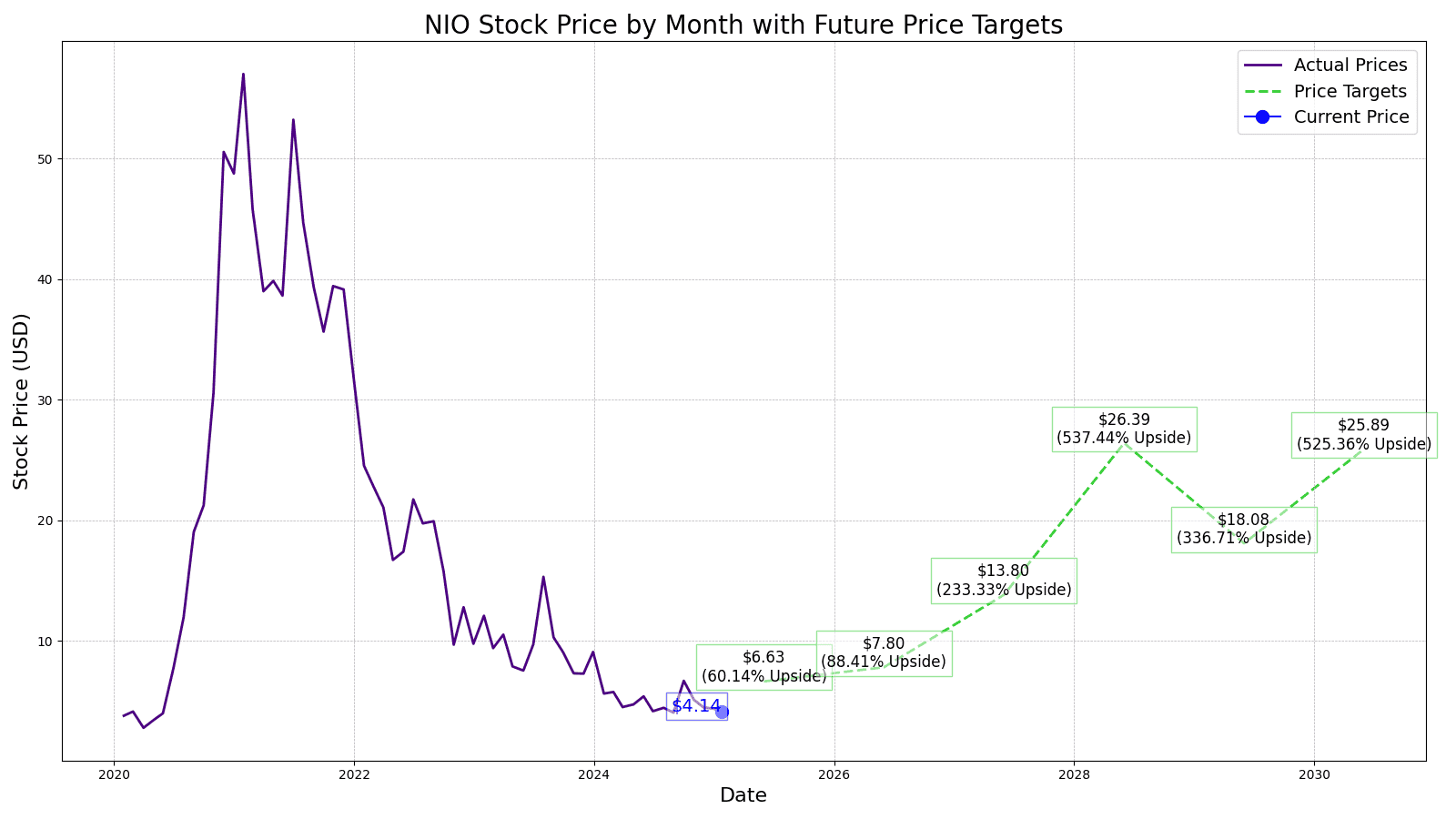Investing
NIO (NIO) Stock Price Prediction and Forecast 2025-2030 For January 24

Published:

Shares of NIO (NYSE:NIO) fell -3.39% on Thursday, putting an end to the rally that all the stock rise 5.42% since Jan. 13. Year-to-date, NIO is down -9.23% and has fallen -33.49% over the past year. On Tuesday, Jan. 7, HSBC cut its outlook for the company from a “Buy” rating to a “Hold” rating.
Earlier this month, NIO rolled out its latest software update to European customers — version 2.4.0 of the Banyan operating system. This update introduces over 50 new features and enhancements, including a new driving mode specifically for the ET5 and ET5 Touring models. Inspired by NIO’s electric supercar, the EP9, this new “EP Mode” driving experience was previously only available in the Chinese market.
The Chinese carmaker’s high-performance models, which feature a +600-mile range, have caught the eye of vehicle enthusiasts and investors, while addressing range anxiety issues by creating battery swap technology as a supplement to charging. NIO is one of the 10 largest vehicle manufacturers in the world and the third largest in China.
From a stock performance standpoint, NIO has been a tale of two stories. When shares debuted on the New York Stock Exchange on Sept. 12, 2018, at $9.90, they struggled to build that momentum. It wasn’t until the summer of 2020 when the stock began to surge, gaining over 810% from June 26, 2020, to Feb. 9, 2021, when the stock hit its all-time high of $62.84. Shares have fallen considerably since, but the long-term outlook remains strong.
24/7 Wall Street aims to provide readers with our assumptions about the stock’s prospects going forward, what growth we see in NIO stock for the next several years, and what our best estimates are for NIO’s stock price each year through 2030.

The following is a table of NIO’s revenues, operating income and share price for its first few years as a public company.
Here’s a table summarizing performance in share price, revenues and profits (net income) from 2014 to 2018.
| Share Price (End of Year) |
Revenues (CNY) | Operating Income | |
| 2018 | $5.39 | 4,951.2 | (9,595.6) |
| 2019 | $3.45 | 7,824.9 | (11,079.2) |
| 2020 | $40.00 | 16,257.9 | (4,607.6) |
| 2021 | $16.70 | 36,136.4 | (4,496.3) |
| 2022 | $7.87 | 49,268.6 | (15,640.7) |
| 2023 | $4.71 | 55,617.9 | (22,655.2) |
Revenue and operating income in Billion CNY (1CNY=.14 USD)
Now let’s take a look at Rivian (NASDAQ:RIVN) the first few years it was a publicly traded company (here is Rivian’s stock price forecast):
| Share Price (End of Year) |
Revenues | Operating Income | |
| 2021 | $50.24 | $55.0 | ($4,220.0) |
| 2022 | $19.30 | $1,658.0 | ($6,856.0) |
| 2023 | $10.70 | $4,434.0 | ($5,739.0) |
| TTM | $15.35 | $4,997.0 | (5,790.0) |
The revenue growth for both firms is similar but Rivian’s operating loss is more than double the yearly operating loss of NIO.
NIO formerly contracted its manufacturing to Jianghuai Automobile Group, paying a fee for each vehicle produced in addition to fixed cost. They have since acquired the factory from JAC. This agreement is beneficial for a young start-up in a very capital-intensive market. However, when scale is reached, the variable cost model has its downsides.

| Year | Revenue | Shares Outstanding | P/S Est. |
| 2025 | 97,052 | 2,050 mm | 1x |
| 2026 | 114,172 | 2,050 mm | 1x |
| 2027 | 134,643 | 2,050 mm | 1.5x |
| 2028 | 257,634 | 2,050 mm | 1.5x |
| 2029 | 176,533 | 2,050 mm | 1.5x |
| 2030 | 189,548 | 2,050 mm | 2x |
Revenue in CYN millions
Compared to Rivian and Tesla, NIO’s price-to-sales valuation will be moderately discounted. While NIO is in solid financial standing and has a premium brand image, it’s still uncertain how much competition the company will face in China and expanding overseas. The company is already spending a quarter of revenues on R&D and if NIO can’t capitalize on this spend, the stock price will be sluggish compared to North American EV manufacturers.

We expect to see a revenue growth of 60% for the year, with a price-to-sales multiple of 1x, which puts our price target at $6.63, an upside of 54.55% from today’s price.
Going into 2026, we estimate the price to be $7.80, with another strong 50%+ revenue bump. However, with EBITDA still well in the negative, we see the market not rewarding the stock as much and giving it a lower valuation multiple, resulting in an upside of 81.82%.
Heading into 2027, we expect the stock price increase to leap forward to $13.80 with another strong 50%+ revenue growth year-over-year. That is a 97% year-over-year gain and up 221.68% from today’s stock price.
When predicting more than three years out, we expect NIO’s P/S ratio in 2028 to be 1.5x and top-line growth of 50%. In 2028, we have NIO’s revenue coming in around $36 billion, suggesting a stock price estimate at $26.39 or a gain of 515.15% over the current stock price.
24/7 Wall Street expects NIO’s stock to continue its revenue growth and to generate $25 billion in revenue. The stock price in 2029 is estimated at $18.08, or a gain of 321.45% over today’s price.
We estimate NIO’s stock price to be $25.89 per share. Our estimated stock price will be 503.50% higher than the current stock price.
| Year | Price Target |
| 2025 | $6.63 |
| 2026 | $7.80 |
| 2027 | $13.80 |
| 2028 | $26.39 |
| 2029 | $18.08 |
| 2030 | $25.89 |
The thought of burdening your family with a financial disaster is most Americans’ nightmare. However, recent studies show that over 100 million Americans still don’t have proper life insurance in the event they pass away.
Life insurance can bring peace of mind – ensuring your loved ones are safeguarded against unforeseen expenses and debts. With premiums often lower than expected and a variety of plans tailored to different life stages and health conditions, securing a policy is more accessible than ever.
A quick, no-obligation quote can provide valuable insight into what’s available and what might best suit your family’s needs. Life insurance is a simple step you can take today to help secure peace of mind for your loved ones tomorrow.
Click here to learn how to get a quote in just a few minutes.
Thank you for reading! Have some feedback for us?
Contact the 24/7 Wall St. editorial team.